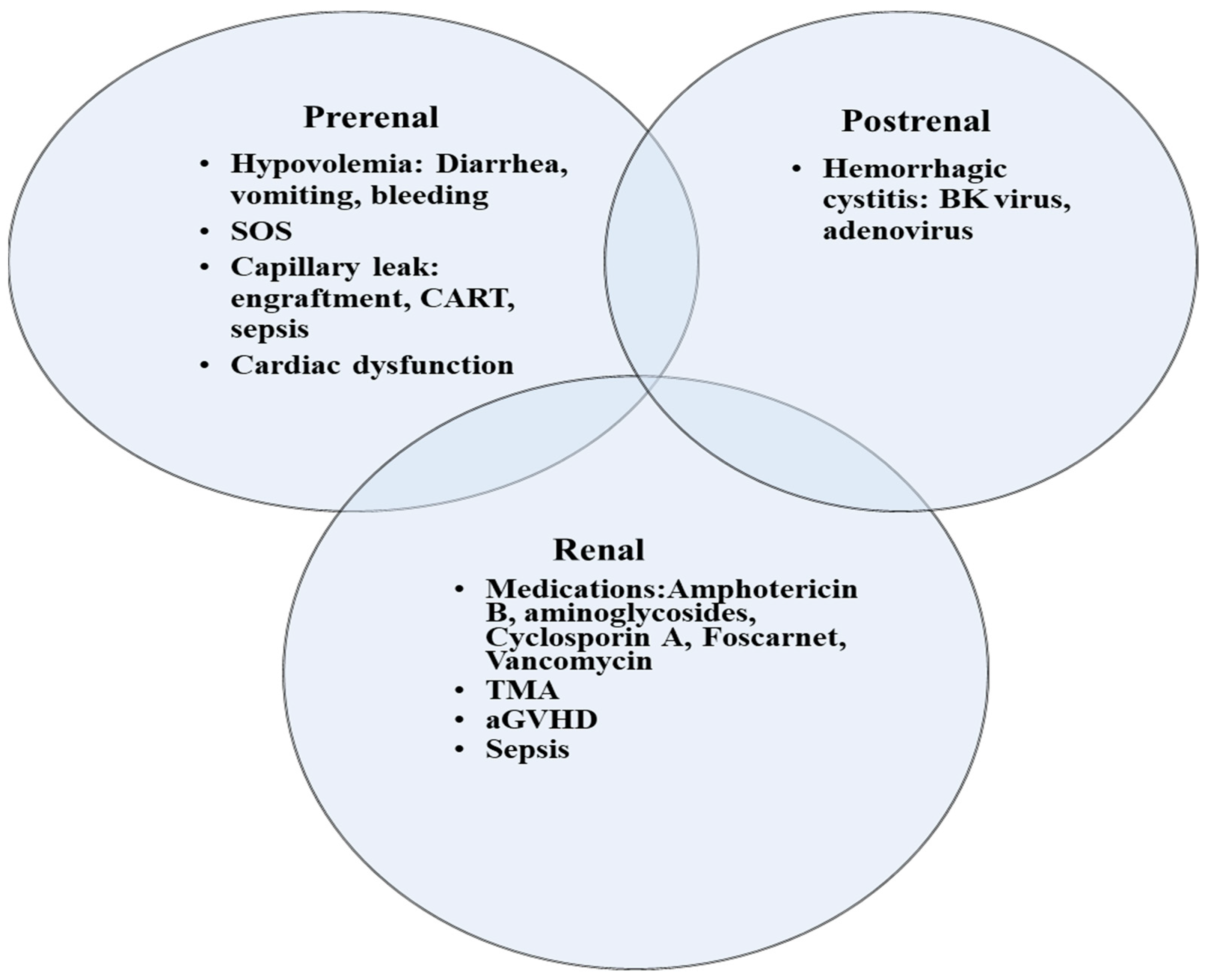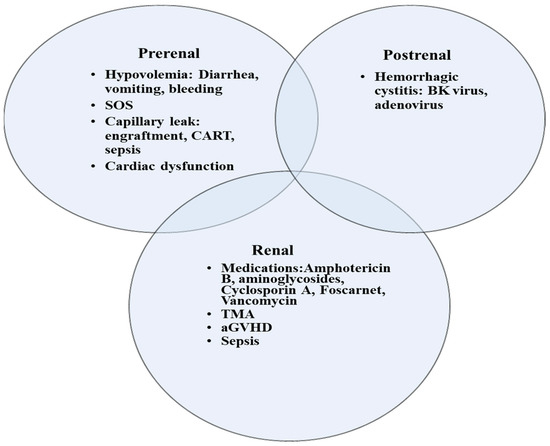Hematopoietic cell transplant (HCT), used for treatment of many malignant and non-malignant pediatric diseases, is associated with serious complications, limiting this therapy’s benefit. Acute kidney injury (AKI), seen often after HCT, can occur at different stages of the transplant process and contributes to morbidity and mortality after HCT. The etiology of AKI is often multifactorial, including kidney hypo-perfusion, nephrotoxicity from immunosuppressive and antimicrobial agents, and other transplant-related complications such as transplant-associated thrombotic microangiopathy and sinusoidal obstructive syndrome. Early recognition of AKI is crucial to prevent further AKI and associated complications. Initial management includes identifying the etiology of AKI, preventing further kidney hypo-perfusion, adjusting nephrotoxic medications, and preventing fluid overload. Some patients will require further support with kidney replacement therapy to manage fluid overload and AKI.
- hematopoietic cell transplant
- kidney injury
- renal replacement therapy
- thrombotic microangiopathy
- continuous kidney replacement therapy
1. Acute Kidney Injury


23. Special Disease Conditions Post HCT That Are Associated with AKI
2.1. Transplant-Associated Thrombotic Microangiopathy
3.1. Transplant-Associated Thrombotic Microangiopathy
2.2. Sinusoidal Obstruction Syndrome
3.2. Sinusoidal Obstruction Syndrome
Sinusoidal obstruction syndrome (SOS) is associated with multiorgan dysfunction and a high mortality rate [10][23]. SOS occurs in the early stage post HCT secondary to cytotoxic therapy or radiotherapy [11][24]. The incidence rate is 20–60%. Diagnosis of SOS is based on the following criteria (two or more criteria present) [12][25]:-
Consumptive and transfusion-refractory thrombocytopenia;
-
Weight gain on 3 consecutive days despite the use of diuretics, or a weight gain of >5% above baseline weight within 72 h;
-
Increase in bilirubin from baseline on 3 consecutive days, or bilirubin ≥ 2 mg/dL within 72 h;
-
Hepatomegaly (best if supported by imaging) above baseline value;
-
Ascites (best if supported by imaging) above baseline.
2.3. Fluid Overload
3.3. Fluid Overload
Fluid overload (FO) is common in critically ill children and negatively affects outcome [14][15][29,30]. Additionally, FO can exacerbate kidney injury by worsening kidney venous hypertension, impairing perfusion pressure capacity of the glomerular capillaries. Cumulative fluid balance is often used interchangeably with fluid overload and is calculated as follows: Fluid intake – Fluid output (L)/ICU admission weight (kg) × 100 [16][31]. FO can also be calculated by comparing current weight to admission weight if fluid balance information is not available. FO > 10% is common in critically ill children and was observed in 33% of a large cohort of 1017 critically ill children [14][29]. FO was associated with higher risk of mortality, kidney adverse events, and increased duration of mechanical ventilation (MV) and ICU stay. A metanalysis including 44 pediatric studies showed a 6% increase in odds of mortality with each 1% increase in FO [15][30]. The adverse effect of FO is also prevalent in the pediatric HCT population [17][18][32,33].2.4. CAR T-Cell Therapy
3.4. CAR T-Cell Therapy
Chimeric antigen receptor (CAR) T-cell therapy, used for treatment of hematologic malignancies, involves the utilization of engineered cytotoxic T-cell to recognize specific tumor antigen. AKI occurs with this therapy secondary to cytokine release syndrome (CRS), a well described complication of this therapy which can lead to organ dysfunction. Hypoperfusion secondary to capillary leak and proinflammatory cytokines contribute to AKI encountered post CAR-T cell therapy. AKI is usually mild in these cases [19][36].34. Continuous Kidney Replacement Therapy
Nearly one-third of patients with AKI require kidney replacement therapy (KRT) [1]. Continuous kidney replacement therapy (CKRT) is used often in the ICU to deliver KRT because it is tolerated better than intermittent hemodialysis (IHD) in hemodynamically unstable critically ill children. During CKRT, fluid removal and solute clearance occur continuously, promoting better control of fluid status. Solute clearance occurs by either convection, diffusion, or both, whereas fluid is removed via ultrafiltration. Hemofiltration modes of CKRT can increase removal of small and medium-sized solutes by convection (solute drag); in contrast, hemodialysis modes mainly remove small-sized molecules by diffusion (concentration gradient). No consensus exists on the optimal time for initiation of CKRT and whether early initiation can improve outcome. Most evidence is from adult randomized trials that compared the early initiation of CKRT to using a standard strategy. One of the largest adult trials, the STARRT-AKI trial, randomized 3019 critically ill adults with AKI to either an accelerated RRT strategy (initiated within 12 h in adult critically ill patients with Stage 2 or Stage 3 AKI) or a standard strategy. The accelerated RRT strategy did not reduce mortality compared to the standard strategy, and survivors of the accelerated RRT strategy had a higher risk of adverse events and dependence on kidney replacement therapy [20][41]. In contrast, in the ELAIN trial that included 231 critically ill patients with AKI, a lower mortality in the early RRT group compared to the delayed initiation group was observed (39% versus 54% respectively) [21][42].45. Transition from CKRT to IHD/Discontinuation of CKRT
The optimal timing for successful discontinuation of CKRT or switch to IHD is difficult to predict. Renal recovery is usually preceded by an increase in urine output. Urine output > 500 cc/day is used in some adult patients as a criterion to discontinue KRT [22][47]. Factors that have been shown to predict successful liberation include the hourly urine output within 12 h before CKRT discontinuation, serum creatinine level within 24 h before liberation, and the cumulative fluid balance (from ICU admission to CKRT discontinuation) [23][48]. In general, children are switched from CKRT to IHD when FO is resolved and they are hemodynamically stable.56. Outcomes of KRT
ICU mortality in children post HCT requiring CKRT is estimated to be 52–65% [2][24][2,49]. The 1-year overall survival rate is also poor (27.4% (95% CI: 16–40.5%, p < 0.0001)) [1]. Reported factors that are associated with mortality include FO > 10%, mechanical ventilation, vasoactive support, and neutropenia at the end of CKRT [2].67. Biomarkers of AKI in Children with HCT
Given the potential shortcomings of sCr as a marker of AKI, several additional biomarkers of AKI have been developed and studied. These biomarkers measure either glomerular function or renal tubular damage and can aid in early detection of AKI (Table 13).| Biomarker | Characteristic | Detection Time | Peak | AUC for AKI Detection | Limitations |
|---|---|---|---|---|---|
| Glomerular injury | |||||
| Cystatin C | 13-kDa protein that is present in all nucleated cells, protease inhibitor | 2–48 h | 6–8 h | Influenced by inflammation, muscle mass, and high-dose steroids | |
| Renal tubular injury | |||||
| NGAL | 25-kDa protein of the family of lipocalins with bacteriostatic function | 2–24 h | 6–12 h | 0.8 (0.72–0.87) | False elevation in sepsis and malignancy |
| NAG | >130-kDa proximal tubular lysosomal enzyme | 2–4 h | 0.6 | Elevated in diabetes and albuminuria | |
| KIM 1 | 38.7-kDa type I transmembrane glycoprotein | 1–24 h | 0.85 | Slow rise and non-specific May be elevated in the settings of chronic proteinuria and inflammatory diseases |
|
| Interleukin-18 | 24-kDa cytokine | 4–48 h | 12 h | 0.75 | Low sensitivity/specificity |
| L-FABP | 14-kDa lipid binding protein | 12–72 h | May lose its specificity when liver disease is present | ||
| TIMP 2 | 21-kDa protein, endogenous inhibitor of metalloproteinase activities, involved in G1 cycle arrest | 1–12 h | 0.8 | Proteinuria interferes with the test results Elevated in diabetes |
|
| IGFBP7 | 29-kDa protein, IGF-1 receptor antagonist, involved in G1 cycle arrest | 0.76 | |||
